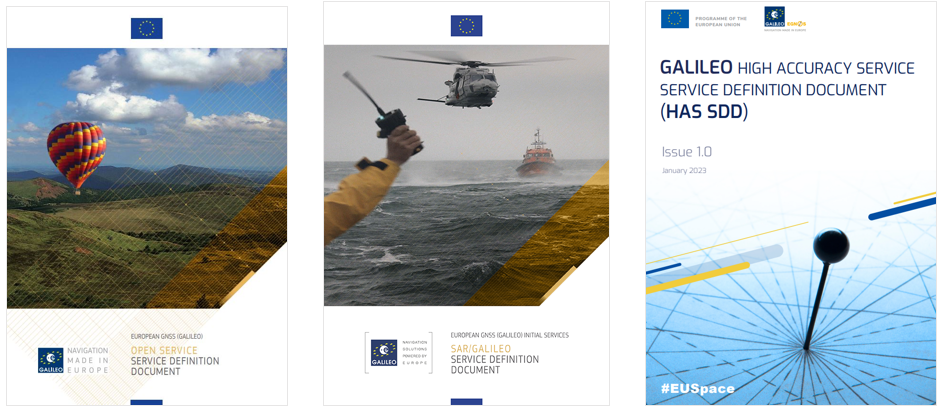The Galileo Open Service (OS), Search and Rescue (SAR) and High Accuracy Service (HAS) Service Definition Documents (SDD) contain essential information about the Galileo OS, SAR and HAS. They provide details on the services' definition, main characteristics, level of performance, and other significant information that gives the reader a comprehensive understanding of these services.
Galileo, the European Union Global Navigation Satellite System, is delivering OS and SAR services since 2016. It provides users with positioning, navigation and timing information and distress alert data detection and Return Link Service. In addition, as of 24 January 2023, the Galileo HAS joined the Galileo services family, delivering orbit and clock corrections as well as signal biases applicable to the Galileo and GPS satellites and signals, allowing the users to achieve improved positioning performance.
The SDD of each service presents a high-level overview, including its main characteristics, the usage conditions, assumptions and limitations and the Minimum Performance Levels (MPLs) expected to be achieved.
Check these documents if you need to know about:
- Service terms and conditions of use
- Service Definition: scope, general concept, coverage area, infrastructures and facilities, outputs
- Operational concept: service centres, data services, maintenance level, operational scenarios and interfaces
- Service Performances: how performances are measured, expectations, availability and limitations, monitoring.
SDD at a glance – relevant information for user communities
Every OS, SAR and HAS potential user is invited to read the corresponding SDD to have a clear picture of the main aspects of these services. The first sections of the documents provide a high-level description of OS, SAR and HAS services, respectively, providing novice users with a good picture of their essentials. Complementary information is available in various Annexes.

OS users may focus on the following topics:
- Assumptions for MPL: which conditions receivers must comply with in order to expect the minimum performance reported in the OS SDD, how parameters are correctly interpreted, the meanings of SIS status, and excluded errors.
- MPL achieved in terms of accuracy and availability:
- Accuracy:
- for Ranging Services: Ranging accuracy for any and overall satellites
- for Time Services: UTC Time and UTC Frequency Dissemination Accuracy
- Availability:
- Per-slot availability
- Availability of the Galileo Single Frequency and Dual Frequency Positioning service
- Availability of the Galileo UTC Dissemination and Determination service
- Availability of the Galileo OS Position Dilution of Precision (PDOP)
- Accuracy:
- Performance Level for the GNSS Service Centre: timely publication of Notice Advisory to Galileo Users (NAGUs)
SAR users may pay attention to:
- Definition of SAR Forward Link Service (FLS) and Return Link Service (RLS), including the delineation of roles and responsibilities of the external contributors.
- MPL, in terms of:
- Detection and Location performance, over the Service Coverage Area (detection and location probability, and location accuracy).
- Availability of SAR/Galileo Services and the relevant Space and Ground Segment infrastructure.
- Service Limitation cases, where users may experience non-nominal performance levels.
- How service performance is monitored and reported.
- How Ground and Space Segment operations are conducted and how to obtain up-to-date operational information.
HAS users may find the following information:
- Description of the characteristics of the Galileo HAS provided through the Galileo Signal-in-Space (SIS) and the Internet Data Distribution (IDD) channels.
- Usage assumptions regarding the use of the HAS corrections and the HAS performance characterisation user algorithm (HAS-UA) used to determine the Galileo HAS typical positioning performance.
- The Galileo HAS committed performance:
- The HAS corrections (products) performance MPLs, in terms of accuracy and availability.
- The Galileo HAS service area, linked to the corrections performance commitments.
- The Galileo HAS typical positioning performance, in terms of accuracy and availability of positioning.
Specific releases of these documents will be issued in line with the evolution of the Galileo services.
Galileo provides Performance Reports every quarter, where the performance of OS, SAR and HAS Services is assessed and compared against the MPL targets defined in the respective SDD.
Complete documents are available at:
OS SDD: https://www.gsc-europa.eu/sites/default/files/sites/all/files/Galileo-OS-SDD_v1.2.pdf
SAR SDD: https://www.gsc-europa.eu/sites/default/files/sites/all/files/Galileo-SAR-SDD.pdf
HAS SDD: https://www.gsc-europa.eu/sites/default/files/sites/all/files/Galileo-HAS-SDD_v1.0.pdf
To keep up with our publications and the latest updates on the EU Space Programme and GSC, subscribe to the weekly Watch This Space Newsletter and register to the GSC web portal.
Media note: This feature can be republished without charge provided the European Union Agency for the Space Programme (EUSPA) is acknowledged as the source at the top or the bottom of the story. You must request permission before you use any of the photographs on the site. If you republish, we would be grateful if you could link back to the EUSPA website (https://www.euspa.europa.eu).